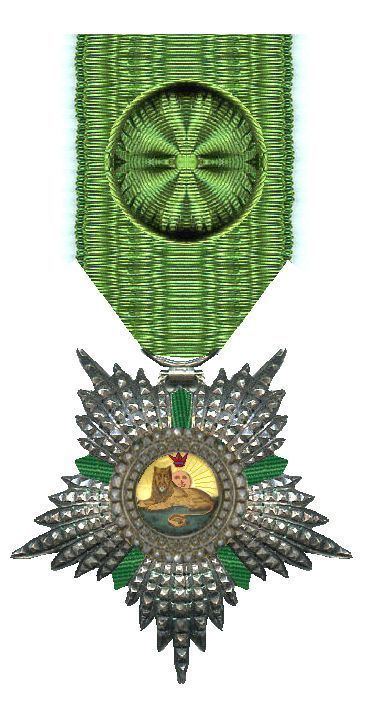The Imperial Order of the Lion and the Sun was instituted by Fat’h Ali Shah of the Qajar Dynasty in 1808 to honour foreign officials (later extended to Persians) who had rendered distinguished services to Persia. In 1925, under the Pahlavi dynasty the Order continued as the Order of Homayoun with new insignia, though based on the Lion and Sun motif. This motif was used for centuries by the rulers of Persia, being formally adopted under Mohammad Shah.
The order was senior to the Order of the Crown. It was issued in five grades.
Major-General Sir John Malcolm was the first foreign recipient in 1810. Other foreign recipients include:
Richard Colley (Wellesley), Marquess Wellesley (1811)Sir Gore Ouseley (1770–1844), British ambassador to Persia and oriental scholar (1812)General Nikolay Rtischev (1754-1835), Russian signatory to the Treaty of Gulistan (1813)Major-General Sir Henry Lindsay-Bethune (1787–1851), Commander of Persian infantry regiments (1816)General Aleksey Petrovich Yermolov (1777—1861), Russian ambassador to Persia 1817 (1817)Sir Robert Ker Porter (1777–1842), artist and diplomat (1819)Charles Maurice de Talleyrand-Périgord (1821)Lieutenant-Colonel Sir Henry Willock, British Envoy to Persia 1815–1826 (1826)Field marshal Ivan Paskevich (1782–1856) (1828)Lieutenant-Colonel Sir John Kinnear MacDonald, British Envoy to Persia 1826–1830 (1828)Abbasqulu ağa Bakıxanov Qüdsi an Azerbaijani writer, historian, journalist, linguist, poet and philosopher (1829)Aleksander Griboyedov (1795 – 1829), diplomat and playwright, Russian ambassador to Persia 1829 (1829)Count Cavour, diplomat and Prime Minister of Kingdom of Sardinia and of Kingdom of ItalySir John McNeill, British Envoy to Persia 1836–1842 (1833)Sir Mancherjee Merwanjee Bhownagree KCIESir George Hayter (1792–1871), British Portrait PainterArmand TrousseauHeinrich Alfred Barb, Austrian University Director, interpreter and scholar of the Persian languageMarshal Francois Achille Bazaine (1811–1888), Marshal of FranceAlexandre Percin, French Brigadier-General.Seth ApcarSir Albert Abdullah David Sassoon (1889)Henry Blosse LynchThomas Kerr LynchGeneral Sir Albert Houtum-SchindlerHonourable Lennox Hannay Lindley, MB, Chief Physician to the Shah of Persia (First class, 1902)Karl Georg Graf Huyn (1909)Edward Granville Browne (1922)Major-General Sir Frederick SykesGeneral Wladyslaw Anders, commanding officer of 2nd Polish Corps in World War II (Western European Theatre), famous for the Battle of Monte Cassino, ItalyErnest Yarrow, Christian missionary and a witness to the Armenian GenocideGeneral Boris Möller, Swedish chief for the second gendarmerie regiment (1914–1915)Baron Eric Hermelin, Swedish translator of classical Persian poetry (1943)Sir Francis Michie Shepherd, (1892-1962), British Ambassador to Persia, 1950-1952.
Anton Chekhov has a short story titled The Lion And The Sun. The story is about a mayor who had "long been desirous of receiving the Persian order of The Lion and the Sun".[1]
